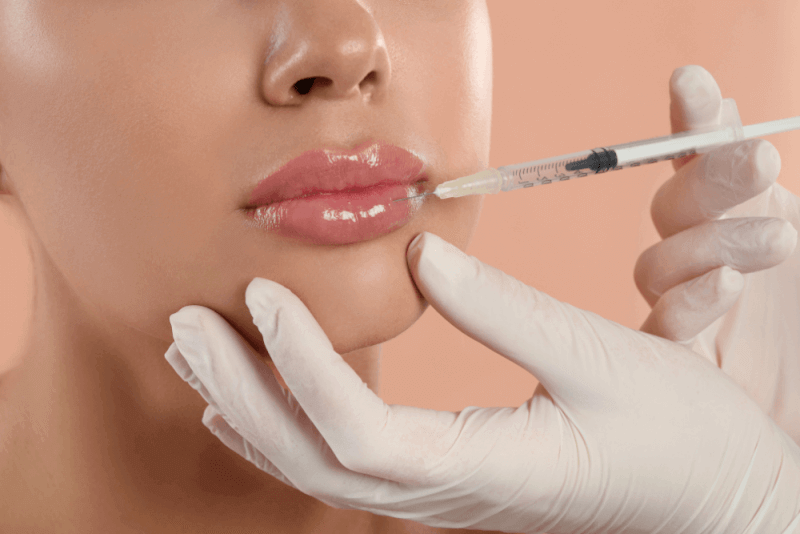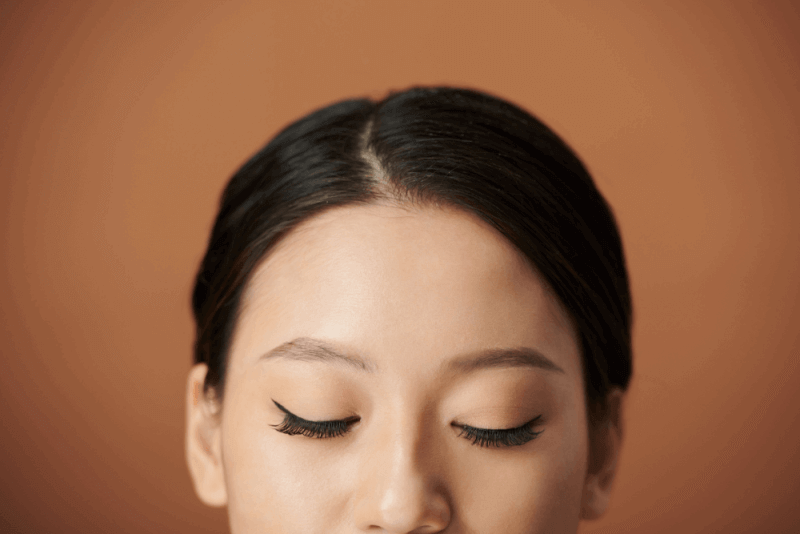What is Lip Filler?
Lip fillers, one of the most popular types of dermal fillers, increase the volume of the lips. Lip fillers typically use synthetic hyaluronic acid, but techniques like fat injection, lip implants, and grafting can also be used. Additionally, there are methods for lip augmentation that do not involve fillers.
Needle-Free Lip Filler
Needle-free lip filler, also known as hyaluron pens, is a procedure that enhances the appearance of fuller lips. The high pressure in the pen delivers hyaluronic acid to the deeper layers of the skin.
The high pressure and spring-loaded piston in the pen push the filler through the lip skin or mucosa to the desired area. A cylindrical tube is used inside the device, which is pressed on one side of the lip while high pressure is released on the other side.
Lip Filler Brands
Various brands of filler materials are used in lip fillers. The most commonly used brands today include:
Radiesse
Although Radiesse provides excellent results when used on other areas of the face, it is generally not recommended for lip fillers because it can cause lumpiness and results take longer to appear.
Restylane
This brand is often used around the lips to increase projection or to plump the lips. It has a firmer texture that makes the lips more defined and is highly effective in enhancing the curvature of the lip corners. Many products in this line contain lidocaine, but lidocaine-free options can be ordered for those with allergies to this substance.
Juvederm
This filler brand offers two different formulas for use around the lips. In addition to plumping the lips, it also highlights the vermilion border. It can be diluted if desired and is also used to smooth fine lines.
The effect of this filler lasts between 6 to 9 months. It is recommended to repeat the treatment once a year to maintain the effect. If there are concerns about the lips becoming larger than expected, it can be applied in multiple sessions.
However, this brand may cause more swelling than other products and is more likely to shift over time. Lastly, the filler should be removed before any surgical procedure is performed around the mouth area.
Belotero
This brand, which contains hyaluronic acid, is also used to smooth fine lines. When using this brand, it is necessary to continue until the tissue turns white. Normally, tissue whitening is a cause for concern among doctors as it can indicate tissue damage, but this is not the case with this brand. One of the advantages of this brand is that it does not cause bruising even when applied superficially.
Teosyal
Because the products of this brand move more easily, there is no heaviness felt as with other brands. For this reason, it has less impact on facial expression compared to other fillers. This advantage allows for more natural movement of the lips.
Zyderm
Zyderm, an implant made from highly purified bovine collagen, is recommended more for smoothing wrinkles rather than lip augmentation. However, it is used in certain areas for lip fillers, particularly in cases of moderate to severe changes.
How is Lip Filler Done?
Lip filler is generally not applied to individuals under the age of 21, as the FDA has not approved its use for those below this age. It is necessary to consult with a doctor before undergoing lip filler. Additionally, mental health and social circumstances should be evaluated. During the assessment, specialists may ask the following questions:
- Reason for getting lip filler
- Expectations
- Is there excessive concern about imaginary or very small flaws in the body?
- Is there encouragement from a spouse, partner, or friends?
Face shape and general health condition are also important factors in the decision to get lip filler. Therefore, an overall health assessment is conducted, including pre-existing health conditions or risk factors. It is also necessary to inform the doctor of any allergies if present.
Before starting the lip filler procedure, topical anesthesia is applied to prevent discomfort. The anesthetic creams used usually contain benzocaine, lidocaine, and tetracaine. The anesthesia cream takes about 15-20 minutes to take effect after application.
The doctor then injects the filler into the lip borders, the cupid's bow of the upper lip, and the oral commissures. No pain is felt during the procedure, but there may be a feeling of pressure and possible tearing in the eyes. The amount of filler used is approximately 1 ml, and the depth of the needle penetration is no more than 2.5 mm.
To prevent swelling and bruising, ice can be applied during the procedure. The total procedure time ranges from 30 minutes to 2 hours. After the filler is applied, gentle massage is performed on the lips to ensure the filler is absorbed.
After the procedure, a 15-minute observation period is required to avoid side effects such as nausea or bleeding. Since the local anesthesia used does not cause drowsiness, the patient can return home alone.
When is Lip Filler Used?
Lip filler is used as a method for lip augmentation. It is generally preferred for the following reasons:
- Lips often thin with age. Lip filler is used to restore the previous lip size.
- Lip filler is used when lips are of different sizes or asymmetrical.
- It can be used to reduce the appearance of wrinkles around the mouth.
- It is preferred to enhance body image.
Who Should Avoid Lip Filler?
Before getting lip filler, it is essential to be in good physical condition. Additionally, lip filler should not be applied if any of the following conditions are present:
- Active infection, such as herpes
- Diabetes
- Lupus
- Blood clotting disorders
Advantages of Lip Filler
The advantages of lip filler include:
- It is considered a safe cosmetic procedure.
- The likelihood of complications and side effects is low.
- It helps boost self-confidence.
- Since it is reversible, the filler can be dissolved if the appearance is not satisfactory.
Swelling After Lip Filler
Swelling can occur for various reasons after lip filler. These reasons include:
- Mild trauma to the tissues caused by the injection process
- The body's inflammatory response to the filler material as a foreign substance
- The amount of filler material used
- The technique applied
Swelling after lip filler usually subsides within 1-2 days. Methods for managing swelling include:
- Applying ice to the area at short intervals
- Keeping the head elevated while sleeping
- Drinking plenty of water
- Avoiding heat and alcohol
- Taking ibuprofen if recommended by the doctor
- Following post-procedure instructions
Although swelling is an expected outcome after the procedure, in some cases, emergency intervention may be necessary. These situations include:
- If the swelling is very severe
- If the swelling does not subside within 1-2 days after the procedure
- If there is intense pain, redness, or discoloration at the application site
- If there is difficulty breathing or swallowing
Lumpiness After Lip Filler
It is common to feel the lips as hard or uneven after lip filler. This condition may persist for 2-4 weeks. During this time, the filler integrates with the lip tissue under the skin and usually resolves on its own. If it does not improve after 4 weeks, a doctor's evaluation is required.
Risks of Lip Filler
There are some risks associated with lip filler. These risks include:
- Bleeding and pain at the injection site
- Reactivation of cold sores
- Discoloration
- Sensitivity
- Infection
- Tissue death if the filler is injected into or around an artery
- Asymmetry in lip size
- Migration of the lip filler to other areas of the face
Post-Lip Filler Care
After getting lip filler, the lips may become sensitive. Swelling typically subsides within 24-48 hours. It is recommended to have a follow-up appointment 2 weeks after the procedure to assess the healing process and the appearance of the filler.
- Apply an ice pack for 10 minutes to reduce inflammation, pain, and swelling.
- Avoid using lipstick, lip balm, or any other cosmetic products on the lips for at least 24 hours.
- Avoid touching, kissing, or puckering the lips within the first 24 hours.
- Do not use a straw during this period.
- Be careful while brushing your teeth.
- Drink plenty of water.
- Avoid exercise for at least 24 hours.
Types of Lip Filler
Lip fillers are generally categorized as permanent or temporary.
Permanent Lip Filler
Several methods are used for permanent lip fillers. Some of these methods have lifelong effects, while others last for an extended period, such as 12 months. Permanent lip filler techniques include:
- Lip implants are the longest-lasting option. Small incisions are made at the corners of the lips, and implants are placed inside the lips.
- Lip lift surgery removes excess tissue between the nose and upper lip or at the corners of the mouth.
Temporary Lip Filler
Temporary lip fillers use various filler materials to add volume to the lips. These filler materials include:
- Hyaluronic acid-based lip fillers
- Autologous lip implants, which use collagen from a previous cosmetic procedure
- Fat transfer







